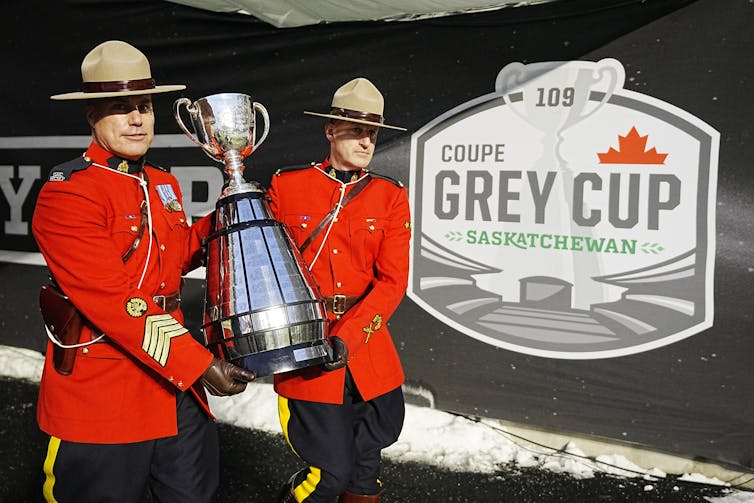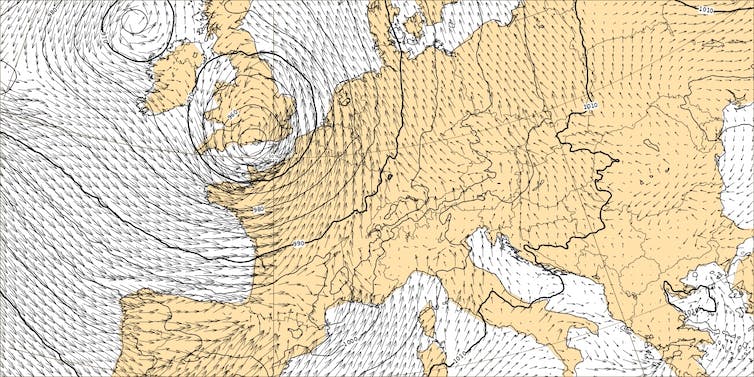As football fans tune into the 110th Grey Cup on Nov. 19, there will most likely be fewer of them watching than in the past. While the Grey Cup and Canadian football were once considered significant national institutions, part of their allure appears to have faded over the years.
Canadian football evolved from British rugby and has been played for over 150 years. The creation of Canadian football was a direct expression of national identity that promoted pride and patriotism, and was a way to differentiate Canada from Britain and the United States.
However, the fact that two gridiron football codes emerged in North America meant that Canadian football, like Canadian culture, would always be compared to American football.
The birth of the Grey Cup
After the inaugural Grey Cup game was played in 1909, the sport quickly grew in popularity. In 1910, special train cars were added from Toronto to transport over 5,000 football fans to Hamilton. More than 12,000 fans attended the game, putting the stadium well over capacity, and fans anxious to get in toppled the gates.
As the game was ending, fans rushed the field, preventing its completion. The following year, at the Grey Cup in Toronto, fans lined up for tickets two days before they went on sale. In 1913, a team from Hamilton travelled west on the first national Canadian football tour, raising the game’s profile further. By 1929, 29 teams in seven leagues across the country were vying for the Grey Cup.
The first victory by a Western team in 1935 helped turn the Grey Cup into a national spectacle, further increasing interest in the game. In 1948, fans of the Calgary Stampeders transformed the Grey Cup football game into a celebration of national unity and identity. Hundreds of Calgarians boarded trains and airplanes and stampeded Toronto in support of their team.
In the 1950s, the popularity of Canadian football was reinforced by the new medium of television. The 1952 Grey Cup game became the most-watched show in Canada’s short television history. In 1954, 92 television stations and 75 radio stations across North America broadcast the Grey Cup game.
THE CANADIAN PRESS/Cole Burston
According to records held by Library and Archives Canada, in 1961 Canadian television ratings showed that CFL games attracted four times as many viewers as NFL games. A survey of Canadians revealed that 92 per cent preferred the CFL to the NFL, and 84 per cent believed the CFL was more exciting.
Decline of Canadian football
Today, the situation has reversed. It is now common for NFL games to have more Canadian viewers than CFL games. Recent surveys show more Canadians follow American football than Canadian football. At one time, Canadians purchased Grey Cup pool tickets and attended Grey Cup parties, but recent surveys show that today, Canadian football fans prefer to watch the Super Bowl over the Grey Cup. In Canada, media coverage of the NFL dwarfs coverage of the CFL and the focus from Canadian media is often negative. Across Canada, it is much more common to see people wearing merchandise from an NFL team than wearing CFL merchandise.
Attendance has yet to return to pre-pandemic levels. Watching a game on television, one often sees more empty seats than filled. In 2012, CFL average attendance was 29,190 but dropped to 21,744 by 2022. As national institutions, the Grey Cup and the CFL appear to be on the decline.
Large new stadiums opened in the 1970s and ‘80s, creating an illusion that the league was doing well. However, the Montreal Alouettes ceased operations in 1982, reemerged and folded again in 1987. The CFL expanded to American locations in search of life-saving revenue, but every U.S.-based team folded. Montréal commenced operations again in 1996, but the Ottawa franchise folded.

Two RCMP officers in red uniforms carrying a large silver trophy walk past a sign that reads: Grey Cup Saskatchewan
The reasons for this shift are numerous. Canada in 2023 is very different than it was in the 1960s. It is a much more multicultural country with opportunities to follow many global sports, including soccer, cricket and rugby. Today, Canadian football is competing with numerous other forms of entertainment.
The political economy of football also conspires against the CFL. The NFL features teams in larger metropolitan areas that generate more media coverage and revenues from advertising and sponsorship.
Additionally, a North American sporting culture has arisen that includes Canadian teams in U.S.-based professional baseball, soccer and basketball leagues. In a globalized world, consumers want access to “world-class” entertainment, which some believe is more likely to feature teams from Los Angeles or New York.
The coveted younger demographic group is less likely to be concerned about place and more likely to be interested in status. The NFL can provide that status. Despite a 2014 survey demonstrating that most Canadians feel that the Grey Cup is an important aspect of Canadian culture and identity, for some, the Cup’s century-long tradition seems antiquated and less appealing.



